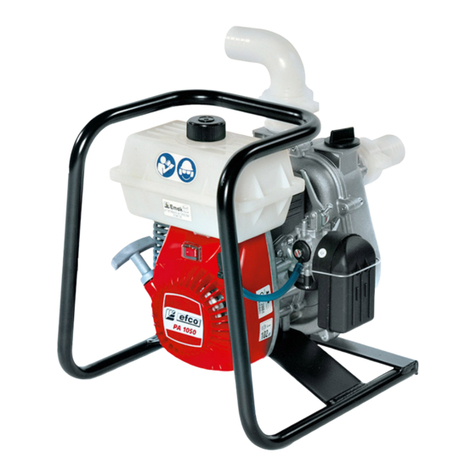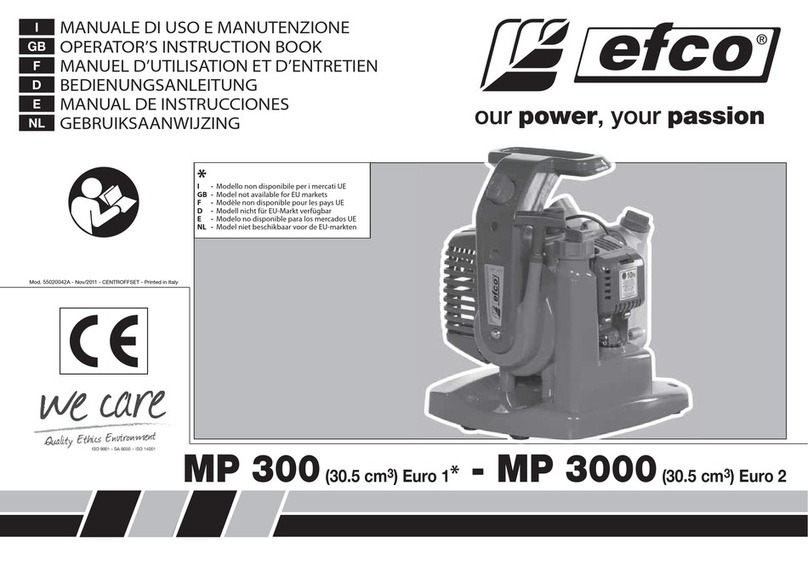
8
1234
Deutsch Español
SICHERHEITSVORKERUNGEN NORMAS DE SEGURIDAD
ACHTUNG - Bei richtigem Einsatz ist die Maschine ein
schnelles, praktisches und leistungsfähiges Arbeitsgerät;
falls Sie sie falsch oder ohne die nötige Vorsicht einsetzen,
kann sie zu einer Gefahr werden. Beachten Sie bitte daher
unbedingt die Sicherheitsvorschriften die Sie nachstehend
in der Betriebsanleitung finden, damit ihre Arbeit immer
angenehm und sicher ist.
ACHTUNG: Das Zündsystem Ihres Geräts erzeugt ein
elektromagnetisches Feld geringer Stärke. Dieses Feld
kann unter Umständen Herzschrittmacher beeinflussen.
Um die Gefahr ernster oder gar tödlicher Unfälle zu
reduzieren, sollten Personen mit Herzschrittmachern vor
Benutzung dieser Maschine ihren Arzt und den Hersteller
des Herzschrittmachers zu Rate ziehen.
ACHTUNG! – Nationale Verordnungen können den Gebrauch
des Geräts einschränken.
Verwenden Sie die Maschine erst, wenn Sie mit ihrem Betrieb1 - vertraut sind. Unerfahrene Benutzer müssen sich vor dem
Arbeitseinsatz mit dem Gerät vertraut machen und dessen
Gebrauch üben.
Die Maschine darf nur von Erwachsenen in guter körperlicher2 - Verfassung verwendet werden, die darüber hinaus in die
Gebrauchsanleitungen eingewiesen sind.
Benutzen Sie die Maschine nicht bei Müdigkeit oder unter3 - Einfluss von Alkohol oder Rauschmitteln (Abb.1).
Immer eine PSA tragen, bestehend aus Handschuhen, Anzug,4 - Schutzbrille und Gehörschutz (S. 10-11).
Halten Sie andere Personen oder Tiere beim Start und5 - Gebrauch der Maschine in einem ausreichenden
Sicherheitsabstand (Abb.2).
Sorgen Sie für eine standfeste Aufstellung der Maschine6 - (Abb.3).
Führen Sie keine Wartung bei laufendem Motor aus.7 - Überprüfen Sie die Maschine täglich auf die einwandfreie8 - Funktion der Sicherheits- und anderen Vorrichtungen.
Arbeiten Sie nicht mit einer beschädigten, behelfsweise9 - reparierten, falsch montierten oder eigenmächtig
umgerüsteten Maschine. Entfernen, beschädigen oder ändern
Sie nie die Schutzvorrichtungen.
Verwenden Sie die Maschine nur in ausreichend belüfteter10 - Umgebung. Benutzen Sie das Gerät nicht in der Nähe von
explosiven oder brennbaren Stoffen, in geschlossenen Räumen
oder in der Nähe von entflammbaren Substanzen (Abb. 4).
Rüsten Sie den Abtrieb der Maschine ausschließlich mit dem11 - Originallaufrad des Herstellers aus.
Lassen Sie stillgelegte Maschinen unbedingt durch den12 - Fachhändler oder eine Wertstoffstelle umweltgerecht
entsorgen.
Geben bzw. borgen Sie die Maschine nur Personen, die über13 - Funktionsweise und Gebrauch genau informiert sind. Geben
Sie den Benutzern der trennschleifer stets die
Gebrauchsanweisung, die vor Arbeitsbeginn gelesen werden
sollte.
Bewahren Sie dieses Handbuch sorgfältig auf und lasen Sie es14 - vor jeder Inbetriebnahme der Maschine.
Sämtliche Schilder mit den Gefahrensymbolen und15 - Sicherheitszeichen müssen sich in einwandfreiem Zustand
befinden. Bei Beschädigung oder Unleserlichkeit müssen sie
rechtzeitig ersetzt werden (siehe Seite 4).
Die Maschine16 - nie ohne Laufrad. Es können sonst beträchtliche
Schäden am Motor enstehen. Der Hersteller kann in diesem
Falle keine Garantie übernehmen.
Arbeiten Sie mit der Maschine nicht in der Nähe von17 - elektrischen Geräten oder Stromleitungen (Abb.5).
Die Laufradflügel sind vor Stößen und Krafteinwirkungen zu18 - schützen; ein beschädigtes Laufrad darf nie zum Einsatz
kommen.
Verwenden Sie die Maschine nicht mit entzündlichen19 - bzw.
korrodierenden Stoffen.
Bauen Sie das Laufrad bzw. Pumpengehäuse nicht in andere20 - Motoren oder Antriebe ein.
Allen Schrauben und sonstigen Befestigungsmitteln21 - nachprüfen. Nichts darf locker sein.
Das Gerät darf ausschließlich für die in der Betriebsanleitung22 - angegebenen Zwecke verwendet werden (siehe seite 23).
Wenden Sie sich füe eventuelle Klärungen oder Eingriffe immer23 - an den Händler hres Vetrauens.
Der Besitzer bzw. Bediener ist in jedem Fall für die Unfälle oder24 - Risiken gegenüber Dritten oder deren Besitz verantwortlich.
ATENCION - Si se utiliza correctamente, la máquina es un
instrumento de trabajo rápido, cómodo y eficaz; si se usa
incorrectamente o sin las debidas precauciones puede
convertirse en un instrumento peligroso. Para que su
trabajo sea siempre agradable y seguro, respete
escrupulosamente las normas de seguridad indicadas a
continuación en el presente manual.
ATENCIÓN: El sistema de encendido de su unidad produce
un campo electromagnético de muy baja intensidad. Este
campo puede interferir con algunos marcapasos. Para
reducir el riesgo de lesiones graves o mortales, las
personas con marcapasos deberían consultar a su médico y
al fabricante del marcapasos antes de utilizar esta
máquina.
¡ATENCIÓN! – El uso de la máquina puede estar limitado
por reglamentos nacionales.
No utilizar la máquina sin antes instruirse sobre el modo de1 - uso. El operador deberá ejercitarse antes de utilizar la máquina
por primera vez.
La máquina debe ser utilizada por personas adultas en buenas2 - condiciones físicas e instruidas sobre las normas de uso.
No utilizar la máquina en condiciones de fatiga física o bajo el3 - efecto de alcohol o drogas (Fig.1).
Utilice los dispositivos de protección individual (DPI)4 - necesarios, en particular guantes, mono de trabajo, gafas de
protección y auriculares (pág. 10-11).
No permitir la presencia de personas o animales en el radio de5 - acción de la máquina durante el arranque y el uso (Fig.2).
Situar la máquina en una posición estable (Fig.3).6 -
No hacer mantenimiento con el motor en marcha.7 -
Controlar la máquina a diario para asegurarse del buen8 - funcionamiento de todos los dispositivos, ya sean de seguridad
u otros.
No trabajar con la máquina dañada, mal reparada, mal9 - montada o modificada arbitrariamente. No quite, dañe, o
vuelva ineficaz ningún dispositivo de seguridad.
Utilizar la máquina sólo en lugares bien ventilados. No usar en10 -































